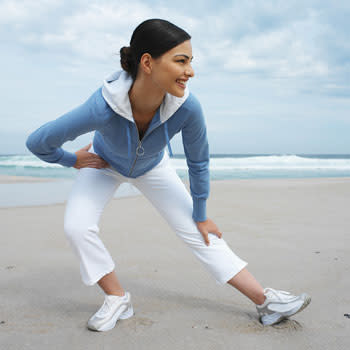Should you stretch before or after working out?
By
Sarah B. Weir

It's summertime, and all across the nation's ball fields, tennis courts, soccer pitches, and golf courses, athletes young and old are engaging in some time honored toe-touching. Then it's "play ball!"
But should you stretch before exercise or after exercise (or both)?
Common wisdom suggests that stretching before an activity improves athletic performance and stretching right after prevents injury and muscle soreness. However, many studies, including a systematic review of research by the School of Physiotherapy at the University of Sydney, say that's not good advice.
Then why do the President's Council on Physical Fitness, the Mayo Clinic, the American Heart Association, and other top health organizations recommend that stretching be a mainstay of any fitness program? The answer isn't as complicated as it seems.
Warming up vs. stretching
Warming up your muscles before engaging in sports is not the same as stretching. Kyle McMinn, Head Strength and Conditioning Coach at Farleigh Dickinson University-Metropolitan Campus, says, "You have to move before movement."
Static stretching -- holding a single stretch for a given amount of time, say 30 seconds -- actually decreases your muscle's explosive power, according to the National Strength and Conditioning Association (PDF). Tests performed on NCAA track athletes and reported in the Journal of Sports Sciences confirm this finding.
On the other hand, a warm up of light aerobic activity such as 5 to 10 minutes of brisk walking, light jogging, or stationary bike riding followed by dynamic stretching is beneficial. McMinn says the goal of warming up is to increase blood flow and core temperature and prepare your muscles to contract and relax efficiently. This can improve performance and helps prevent muscle pulls and other common sports injuries.
Just don't over do it, especially before a competition: A study by the University of Calgary published in May, 2011, suggests that spending too long on a warm up routine can fatigue muscles.
Dynamic stretching
Dynamic stretching uses momentum to propel a muscle through its full range of motion without over-lengthening. The movements are geared to specific sports. A runner might swing their knees up in an exaggerated stride to open up the hips, quads, and hamstrings, while a golfer could use standing trunk rotations to loosen up the torso and shoulders.
Static stretching after exercise
Static stretching can be safely employed after exercising, though according to the Journal of Athletic Training, it won't prevent injury or even muscle soreness.
However, static stretching will improve overall flexibility and range of motion -- a positive for most people who work at a computer or on their feet all day. It's also an enjoyable way to transition from a hard work out to a more relaxed state.
Stretching do's and don'ts
Do warm up before any kind of stretching
Don't bounce; "ballistic stretching" may be appropriate in certain circumstances guided by an experienced trainer or coach, but bouncing can create small muscle tears and tightness.
Don't use static stretching before weight lifting, sprinting, or other activities that require explosive muscle power.
Don't overdo it -- gradually work toward full extension but back off if you feel pain.
Don't stretch an injured muscle unless directed to by your doctor or physical therapist.
Do balance stretching with strength training and cardio; a healthy body requires all three.
